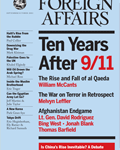In late 2001, when U.S. forces expelled the Taliban from Afghanistan, the country appeared headed for a breakup. The United States and the rest of the international community feared that Afghanistan’s rival ethnic groups would use their regional power bases to pull apart any unitary state, forming in its place independent ministates or aligning with their ethnic brethren across Afghanistan’s borders. At the time, such fears seemed credible: NATO troops were still dealing with the fallout from the violent disintegration of the former Yugoslavia in the 1990s.
The Afghans themselves, however, were less concerned about their country dividing. After all, Afghanistan has been a single state for more than 250 years. If the country were going to split, it would have done so in the 1990s, during its protracted civil war. Yet it did not. No Afghan leader of any political stripe or ethnicity endorsed secession at any time during the last century. Nor did ny at the start of this one. Although Afghanistan’s various ethnic factions disagreed about how the country’s new government should be organized and who would wield power within it, they all proclaimed their support for a unitary state.
This article was originally published by Foreign Affairs. You can read the rest of the article here.
You can read exclusive content from Gateway House: Indian Council on Global Relations, here.
Copyright © 2011 by the Council on Foreign Relations, Inc


